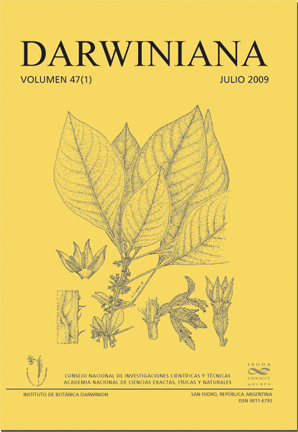Selection criteria in processes of plant manipulation: ethnobotanical contribution to the interpretation of Cucurbita sp. archaeobotanical remains
DOI:
https://doi.org/10.14522/darwiniana.2014.471.40Keywords:
Crop, ethnoarchaeology, ethnobotany, morphotypeAbstract
In this paper, an ethnobotanical-ethnoarchaeological study of different local landraces of Cucurbita maxima subsp. maxima, Cucurbitaceae, was carried on. The aim was to evaluate if different qualitative and quantitative seed characters of these local landraces, as well as those which came from plantsresulting from cultivation or husbandry, get together or not in different morphotypes which materially reflect the diversity locally recognized, as well as local practices. The construction of these morphotypes is proposed as a way to recognize local landraces and different forms of Man - plant interactions in archaeobotanical samples. Domesticated plants are the result of actions derived from selection criteria socially built and transformed, therefore they can constitute different morphotypes which act as carriers of social meanings. For this reason we believe that an ethnoarcheological ethnobotany which generates models to contrast in paleoethnobotanical work will be a good option. Macroscopical morphological descriptors commonly used in archaeobotany were employed together with new micromorphological ones. It was concluded that quantitative micromorphological characters are the most adequate ones to create morphotypes which correspond with locally recognized landraces and with husbandry practices locally developed upon vegetable populations.
Downloads
Published
31-07-2009
How to Cite
Lema, V. S. (2009). Selection criteria in processes of plant manipulation: ethnobotanical contribution to the interpretation of Cucurbita sp. archaeobotanical remains. Darwiniana, Nueva Serie, 47(1), 35–55. https://doi.org/10.14522/darwiniana.2014.471.40
Issue
Section
Archeobotany and Ethnobotany
License

Starting on 2012, Darwiniana Nueva Serie uses Licencia Creative Commons Atribución-NoComercial 2.5 Argentina .






